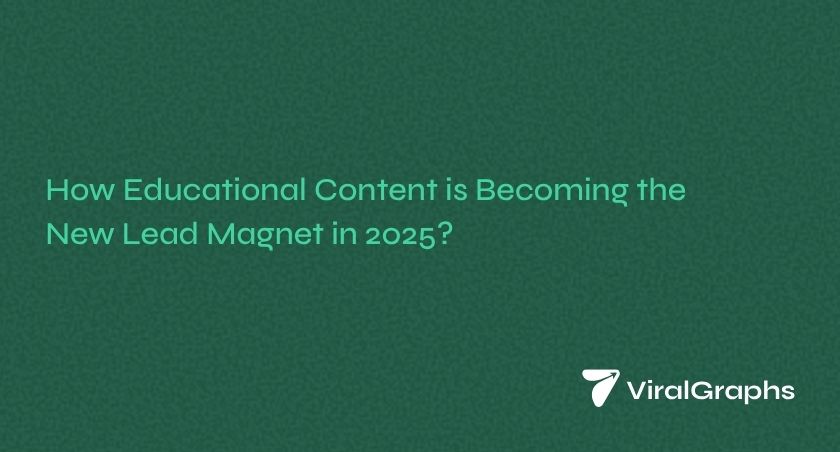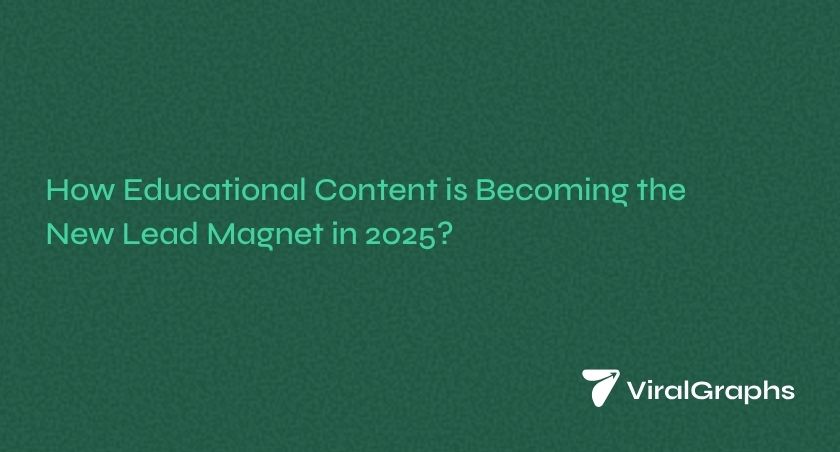
Educational content is quickly becoming the most effective lead magnet across industries, especially in education. In 2025, people don’t want to give up their email for a generic eBook because they want real value, fast.
The days of static checklists and one-size-fits-all PDFs are fading. Today’s audience is more thoughtful, more selective, and constantly bombarded with content. To capture their attention and their contact info, you need to teach, not just tease.
Let’s understand why this shift is happening, how to create lead magnets that actually convert, and why educational pieces of content are outperforming traditional methods in 2025.
Why Does Educational Content Build Trust?
Educational content builds trust among your target audience by demonstrating expertise, offering value, and fostering genuine connections. It positions a brand or individual as a reliable and knowledgeable source, making people more likely to trust their paid offerings or services. Let’s understand this in a more detailed way:
1. Demonstrating Expertise
- Authority in the Niche: Sharing valuable educational pieces of content positions you as a leader in your field.
- Problem Solving: Providing practical solutions to common challenges showcases your understanding of your audience’s needs.
- Thought Leadership: Discussing industry trends and innovations positions you as a forward-thinking source.
2. Offering Value
- Free Information: Providing valuable content without expecting immediate return demonstrates generosity and builds goodwill.
- Solutions to Problems: Education content helps users solve problems, making them more likely to trust the source of that information.
- Continued Engagement: Providing resources that help users navigate their learning goals encourages repeat visits and builds long-term engagement.
3. Fostering Connections
- Transparency: Revealing company processes, values, and challenges builds trust by showing vulnerability and authenticity.
- Two-Way Communication: Engaging with viewers’ questions and comments fosters a sense of community and connection.
- Genuine Interactions: Educational content can serve as a gentle invitation for further engagement, potentially leading to collaborations or business opportunities.
4. Building a Positive Reputation
- Positive Reviews: When customers find value in your content, they’re more likely to recommend your brand to others.
- Brand Awareness: Sharing valuable content increases brand visibility and awareness among your target audience.
- Long-Term Relationships: Consistently delivering valuable content fosters long-term trust and credibility with your audience.
Why Traditional Lead Magnets Are Losing Effectiveness?
Not too long ago, offering a free PDF or checklist was enough to grow your email list. However, by 2025, audiences are increasingly overwhelmed and unimpressed.
Static lead magnets like generic templates, outdated eBooks, or recycled “10 tips” PDFs are falling flat. And, the problem is that these assets often lack real substance. They’re locked behind a form, offer minimal value, and fail to solve the user’s actual problem.
User behavior has changed. Today’s digital consumer expects instant gratification and transparency. They want to see the value before they commit their email address. If they don’t get that value upfront, they bounce.
This shift is forcing marketers to reassess their approach to lead generation. And the answer is “Educational Content” that provides real insights, answers pressing questions, and makes users feel smarter.
The Rise of Educational Content as a Lead Magnet
Educational pieces are considered the lead generation content in today’s timeline that are not just another content format but are becoming the magnet that pulls in today’s high-intent leads. Unlike static downloads, the academic content delivers value immediately.
Whether it’s a deep-dive blog, a short explainer video, or a mini-course, it solves problems in real time, no form fill required. And that transparency builds trust faster than any gated checklist ever could.
This approach is particularly effective when targeting audiences in research-intensive industries, such as education. Students and parents actively seek answers before taking action.
So, we can say that teaching is the new selling. And if your content educates well, your audience won’t need convincing. They’ll come to you, ready to convert.
What Makes Educational Content Convert in 2025?
Not every educational message is created equal. In 2025, content that converts shares a few key traits like flexibility, depth, and omnichannel visibility.
1. Depth Over Gimmicks
Surface-level content no longer suffices. Today’s audience values content that goes deep, such as in-depth guides, visual explainers, or breakdowns with clear and actionable steps.
The more your content marketing strategy mirrors a real solution, the more likely users are to engage and convert. You can aim for “solution-first” content, addressing a pain point directly, and then teaching how to solve it in under 5 minutes.
2. Format Flexibility
People learn in different ways. That’s why smart marketers repurpose a single educational piece of content into multiple formats, such as carousel posts, mini-videos, blog summaries, infographics, and podcast clips.
Short-form video tutorials are especially dominant in 2025. They increase engagement by up to 41% more than static blog content.
3. Multi-Channel Distribution
Educational content performs best when distributed smartly, like:
- Blog post: shared via LinkedIn carousel.
- YouTube video: embedded in a landing page.
- Checklist: converted into Instagram stories.
With the right omnichannel strategy, your lead magnet for education doesn’t just sit on a page, but works across platforms to educate, attract, and convert.
How to Build Your Own Educational Content Lead Magnet?
Creating an educational lead magnet that actually converts is not luck but a properly refined strategy. Here’s a step-by-step framework that can help you build one that drives outstanding results:
Step 1: Identify Real User Pain Points
You can start by researching what your audience is struggling with.
- Use tools like Google’s “People Also Ask,” Reddit, Quora, or in-house FAQs.
- Ask your sales or admissions team what questions prospects keep asking.
- The more specific the problem, the more compelling the content.
Step 2: Choose the Right Format
Don’t default to PDFs. Match format to intent:
- How-to video for visual learners.
- A blog series or guide for SEO traffic.
- Mini-course or email series for nurturing.
Step 3: Capture Leads with Intent-Based CTAs
Skip the generic “Subscribe Now.” Use CTAs like:
- “Get the step-by-step guide students use to improve retention by 30%”
- “Download the exact framework 50+ schools used to boost applications.”
Step 4: Nurture with Post-Download Value
- Once someone opts in, deliver more than they expect.
- Use a short email drip focused on insights, not sales pitches. Keep educating.
When you lead with learning, you earn more than just an email. You earn trust.
Why This Works Especially Well for the Education Industry?
Educational content as a lead magnet is not only a trend but also customized for the education industry. No matter if you are marketing a school, an edtech platform, or a training service, your audience is already in “learning mode.”
Your users are researching, comparing options, and seeking clarity. If your content teaches them before they even ask, you quickly gain authority.
Parents, students, and professionals want to make informed decisions. Students are most likely to contact an institution after engaging with at least three educational pieces of content. This means your content can guide the journey from curiosity to conversion, even before sales are involved.
Also Read – Best Brands Winning at Content Marketing
Conclusion
Educational content is leading a transformation. It builds trust, answers fundamental questions, and aligns perfectly with how modern audiences make decisions, especially in the education space.
When done right, it not only attracts leads but also creates loyal advocates who already see your brand as a trusted guide. So, forget the outdated PDFs and start thinking like a teacher.


